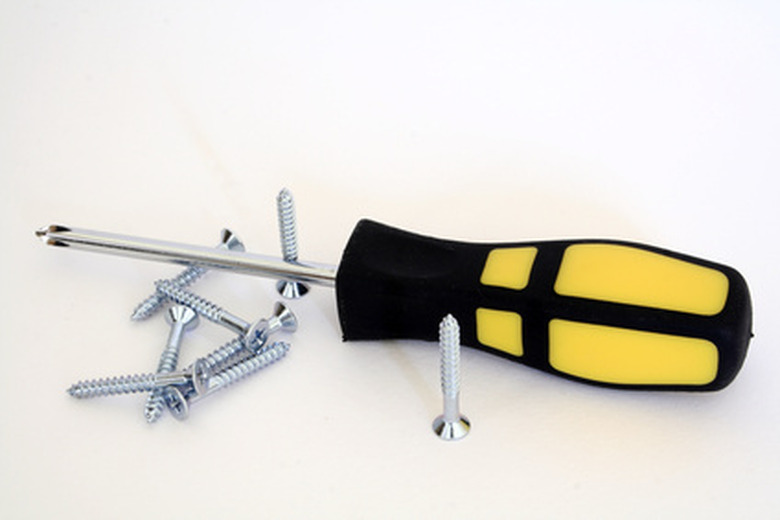How To Calculate The Mechanical Advantage For A Wheel And Axle
You don't usually think of a screwdriver as a wheel and axle, but that's what it is. The wheel and axle is one of the simple machines, which include levers, inclined planes, wedges, pulleys and screws. What all these have in common is that they allow you to alter the force necessary to complete a task by altering the distance through which you apply the force.
Calculating the Mechanical Advantage of a Wheel and Axle
Calculating the Mechanical Advantage of a Wheel and Axle
To qualify as a simple machine, a wheel and axle must be permanently connected, and the wheel, by definition, has a larger radius R than the axle radius r. When you turn the wheel through a complete revolution, the axle also turns through one complete revolution, and a point on the wheel travels a distance 2πR while a point on the axle travels a distance 2πr.
The work W you do to move a point on the wheel through a complete revolution is equal to the force you apply FR times the distance the point moves. Work is energy, and energy must be conserved, so because a point on the axle moves a smaller distance, the force exerted on it Fr must be greater.
The mathematical relationship is:
\(W = F_r × 2πr/\theta = F_R × 2πR/\theta\)
Where θ is the angle that the wheel is turned.
And therefore:
\(\frac{F_r}{F_R} = \frac{R}{r}\)
How to Calculate Force Using Mechanical Advantage
How to Calculate Force Using Mechanical Advantage
The ratio R/r is the ideal mechanical advantage of the wheel and axle system. This tells you that, in the absence of friction, the force you apply to the wheel is magnified by a factor of R/r at the axle. You pay for that by moving a point on the wheel a longer distance. The distance ratio is also R/r.
**Example:** Suppose you drive a Phillips screw with a screwdriver that has a handle that is 4 cm in diameter. If the tip of the screwdriver has a diameter of 1 mm, what is the mechanical advantage? If you apply a force of 5 N to the handle, what force does the screwdriver apply to the screw?
**Answer:** The radius of the screwdriver handle is 2 cm (20 mm), and that of the tip is 0.5 mm. The mechanical advantage of the screwdriver is 20 mm/0.5 mm = 40. When you apply a force of 5 N to the handle, the screwdriver applies a force of 200 N to the screw.
Some Wheel and Axle Examples
Some Wheel and Axle Examples
When you use a screwdriver, you apply a relatively small force to the wheel, and the axle translates this into a much larger force. Other examples of machines that do this are doorknobs, stopcocks, waterwheels and wind turbines. Alternatively, you can apply a large force to the axle and take advantage of the larger radius of the wheel. This is the idea behind automobiles and bicycles.
By the way, the velocity ratio of a wheel and axle is related to its mechanical advantage. Consider that point "a" on the axle makes a complete revolution (2πr) is the same time as point "w" on the wheel makes a revolution (2πR). The velocity of point Va is 2πr/t, and the velocity of point Vw is 2πR/t. Dividing Vw by Va and eliminating common factors gives the following relationship:
\(\frac{V_w}{V_a} = \frac{R}{r}\)
**Example:** How fast does a 6-inch car axle have to spin to make the car go 50 mph if the diameter of the wheels is 24 inches?
**Answer:** With each revolution of the wheel, the car travels 2πR = 2 × 3.14 × 2 = 12.6 feet. The car is traveling 50 mph, which equals 73.3 feet per second. Therefore, the wheel makes 73.3 / 12.6 = 5.8 revolutions per second. Since the mechanical advantage of the wheel and axle system is 24 inches / 6 inches = 4, the axle makes 23.2 revolutions per second.
References
Cite This Article
MLA
Deziel, Chris. "How To Calculate The Mechanical Advantage For A Wheel And Axle" sciencing.com, https://www.sciencing.com/calculate-mechanical-advantage-wheel-axle-6544256/. 21 December 2020.
APA
Deziel, Chris. (2020, December 21). How To Calculate The Mechanical Advantage For A Wheel And Axle. sciencing.com. Retrieved from https://www.sciencing.com/calculate-mechanical-advantage-wheel-axle-6544256/
Chicago
Deziel, Chris. How To Calculate The Mechanical Advantage For A Wheel And Axle last modified August 30, 2022. https://www.sciencing.com/calculate-mechanical-advantage-wheel-axle-6544256/
